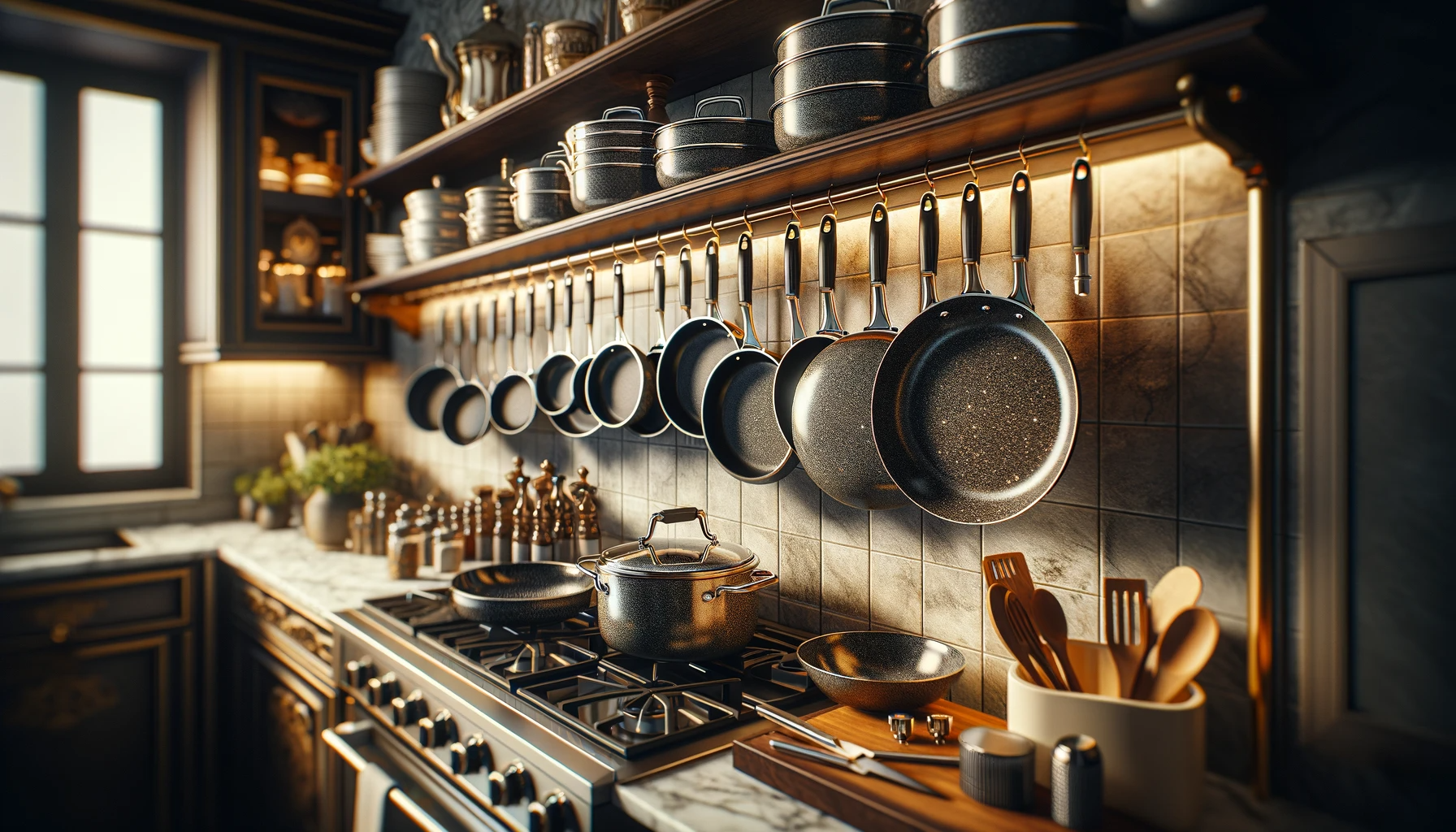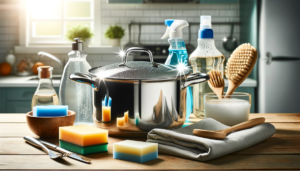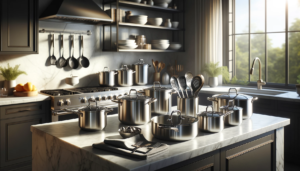With so many cookware options lining store shelves, deciding between durable granite or flexible stainless steel pots and pans can get overwhelming.
By comparing critical factors like longevity, cooking performance, cost, and ease of use, we can determine whether natural stone or metal is the better kitchen investment.
Let’s dive in and contrast granite and stainless steel across these key areas.
Granite Cookware vs Stainless Steel: Which is Better?
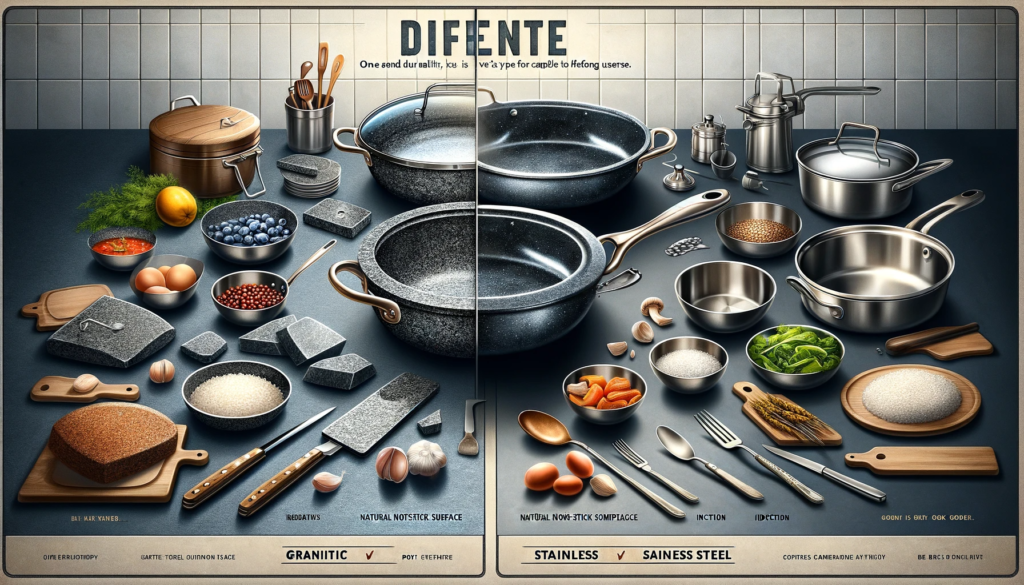
Ultimately, granite cookware edges out stainless steel as the generally better option for most home cooks.
Thanks to its rugged durability that allows lifelong use, excellent heating properties that prevent cold spots, and natural nonstick surface requiring less oil, granite delivers exceptional performance.
Yes, stainless steel costs less upfront and offers induction compatibility.
But granite pays off its higher price over decades of reliable cooking and matches stainless steel in most other ways.
We’ll explore the comparison further, but the gist is granite cookware should be the first choice for shoppers wanting their next pots and pans to potentially be their last.
Durability
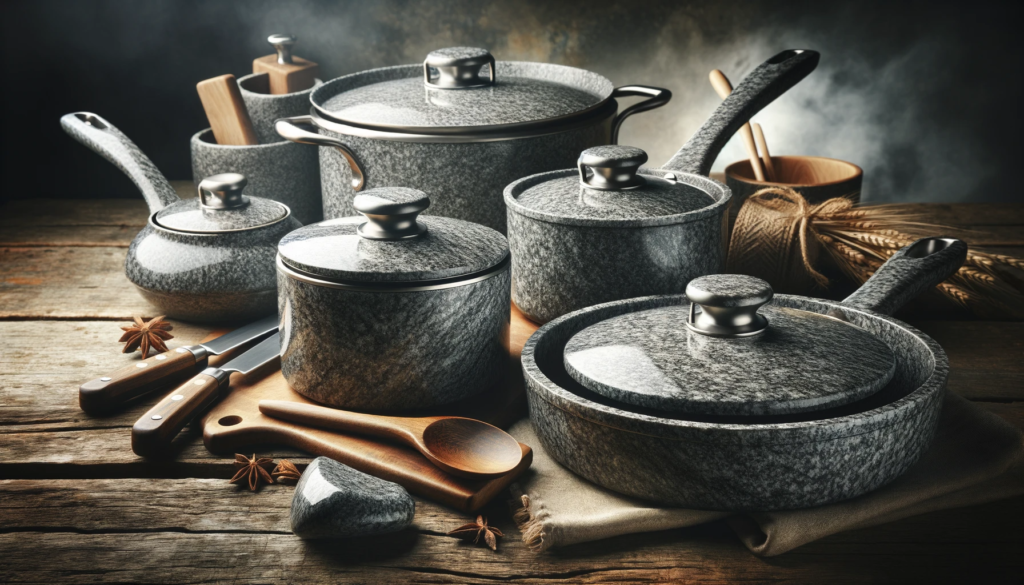
Granite cookware is more durable and less prone to scratches and dents compared to stainless steel.
Being crafted from natural stone, granite is incredibly hard and withstands the rigors of daily cooking very well.
Even metal utensils will not damage granite cookware.
Stainless steel, while durable, can get scratched and dented, especially if dropped.
Light scratches on stainless steel can also lead to further damage over time.
Granite’s rugged construction allows it to be passed down for generations if properly cared for.
Stainless steel cookware may last for many years but will likely need replacing at some point from wear and tear.
Those wanting cookware that holds up extremely well over many decades would do best with granite.
Heat Conductivity
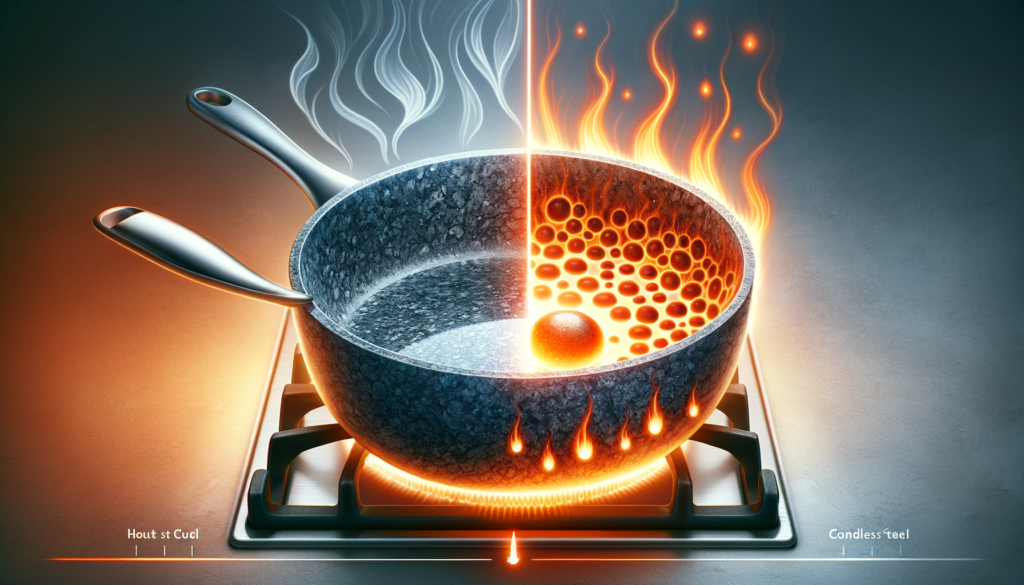
An important consideration when choosing cookware is how evenly and efficiently it conducts heat.
Granite excels in this area, allowing for food to cook evenly no matter where it’s placed in the pan.
The natural stone readily absorbs heat and distributes it consistently to avoid under or overcooking.
Stainless steel, on the other hand, is prone to hot and cold spots resulting from uneven heat distribution.
Foods cooked in granite can develop a nice fond since the pan surface heats thoroughly.
Stainless steel doesn’t get hot enough in certain areas for fond to properly form.
Home cooks desiring even cooking with good fond creation should opt for granite over stainless.
The stone’s thermal properties simply outmatch stainless in terms of heat conductivity.
Maintenance

Maintenance and care are where granite and stainless steel cookware differ quite a bit.
Granite’s rugged, nonporous surface doesn’t absorb odors or flavors and makes cleaning very simple.
Just a rinse or quick scrub is all that granite typically needs to keep it in great shape.
Harsh chemicals that can be required for stainless steel are not necessary.
By contrast, food can stick to stainless steel if the surface isn’t cared for.
This requires more scrubbing and sometimes Barkeepers Friend or other cleaners to remove stuck-on debris.
While granite itself needs little maintenance, the sealant applied to it needs reapplying every so often.
This helps prevent staining and damage from acidic foods.
Stainless steel has no such requirement, making it a lower maintenance option.
Those who don’t want to deal with resealing would be better served going with stainless.
But granite itself is quite simple to care for.
Weight

An obvious difference between granite and stainless steel cookware is weight.
Constructed from natural stone, granite pans are substantially heavier than stainless steel ones.
While excellent heat retention properties arise from granite’s density, the weight also makes the cookware less convenient to move around.
Stainless steel is noticeably lighter in comparison, making it easier to transfer from stove top to oven or lift full pans for serving.
The extra heft of granite does provide stability while cooking or stirring, minimizing movement on the stovetop.
Lightweight stainless steel can sometimes inch around when agitated.
Those with strength or mobility issues may have difficulty managing heavier granite cookware.
But its stability can be preferable for more vigorous cooking.
Health Safety

When it comes to health safety, granite has a notable advantage over stainless steel.
Being an inert natural material, granite doesn’t release any chemicals or substances during cooking.
It has no coatings that could potentially chip off like some pans.
Stainless steel is also inert but there is a small risk with certain types that nickel or chromium could leach into foods, especially acidic items like tomatoes or vinegar.
This primarily occurs with lower grade stainless steel or from damage like scratches and pits.
For those wanting to minimize any potential health risks, granite is the best bet.
Stainless steel is largely safe as well but tiny amounts of metals making their way into food have been occasionally documented.
This isn’t alarming enough to make stainless steel totally unsafe, but granite offers extra peace of mind.
Cost

One area where stainless steel clearly bests granite is cost and budget-friendliness.
Quality stainless steel cookware can be purchased for very reasonable prices, even from high-end brands.
Granite demands a premium, resulting in pieces costing significantly more than comparable stainless options.
Granite’s status as a luxury material factors into its typically lofty price tag.
While costs vary, expect to spend at least double or triple for granite.
Of course, granite also lasts substantially longer than stainless steel when maintained properly.
This helps offset the higher initial investment over decades of use.
Those lacking the budget for granite could consider stainless steel a more affordable alternative.
Prioritizing longevity makes granite’s cost easier to swallow.
Aesthetics
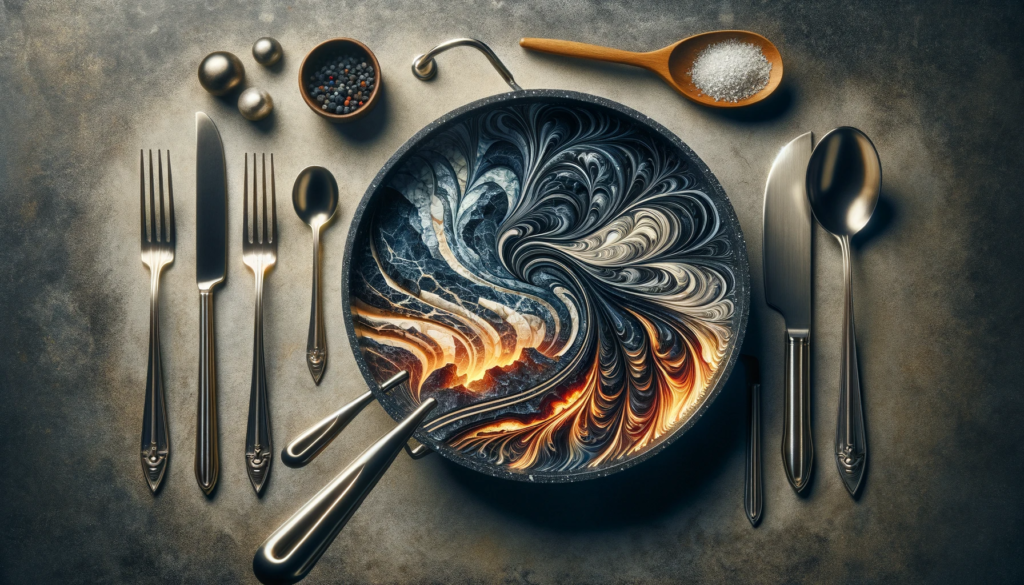
With aesthetics, it comes down to taste and style preference.
Granite undoubtedly provides a striking, unique look few other cookware types can match.
Every piece flaunts natural patterns and colors that stainless steel simply doesn’t offer.
Granite makes a statement, lending an artistic, hand-crafted appearance other materials can seem mass-produced by comparison.
Stainless steel gives off an industrial, utilitarian vibe that many appreciate for its no-frills, metallic gleam.
Granite suits modern and contemporary kitchens wanting to incorporate natural elements with some visual flair.
The stone looks especially sharp displayed on open shelves or racks.
Stainless steel fits right into more casual, farmhouse or industrial style kitchens.
Those desiring a bit more personality from their cookware would likely lean toward granite’s artisanal style.
Versatility
When considering what cooktops the pans will work on, stainless steel takes the edge for versatility.
Its conductive construction allows using stainless cookware on any stovetop surface, including induction which requires magnetic properties.
Granite pans don’t contain iron so they won’t heat up on induction ranges.
Gas, electric, ceramic, halogen etc.
all pose no issues for granite, but induction compatibility is lacking.
If you have an induction cooktop or think you may get one down the road, stainless steel makes the better choice.
Granite will leave you stuck with other cooking surfaces.
Some granite pans feature stainless steel bases to allow induction capability but this slightly defeats the purpose of all-natural cookware.
For maximum versatility going forward, stainless steel is tough to beat.
Additional Factors
Some other considerations when choosing between granite and stainless steel cookware include oven safety, pan weight varieties available, boasting plain or decorative looks, displaying or storing, and types of foods cooked best.
Consider how you plan to use the pans most when deciding between these two great options.
Granite and stainless steel both make excellent additions to any kitchen.
Identify whether durability, cost, versatility or other attributes rank highest for your needs.
Oven Safety
Stainless steel pans often have plastic handles that can melt under high oven temperatures, limiting usefulness for baking and broiling.
Granite cookware handles are typically metal or stone and withstand oven heat fine.
Granite pans can go straight from stovetop to oven with no worries.
Those planning to bake casseroles or roast meats in the cookware itself would benefit from granite’s oven safety.
Available Weights
Another difference is available weights for each material.
Granite cookware is confined to heavier pieces given the density of stone.
Lightweight granite simply doesn’t exist.
Stainless steel pans are produced from thin sheets of alloy and come in a wide range of thicknesses.
This allows for very light stainless cookware perfect for backpacking or RVing.
Granite cannot compete here.
Visual Styles
The aesthetic options contrast nicely as well.
Granite cookware retains its natural appearance and coloring derived from the unique mining source.
At most, smooth polished or matte finishes get applied.
Stainless steel accepts many additional treatments like brushed patterns or colored exteriors like black, red or blue.
While stainless steel takes to decorative enhancements better, plain granite lets its innate beauty speak for itself.
Displaying and Storing
Home chefs wanting to showcase their top pots and pans may prefer granite’s striking artisanal looks over stainless steel’s industrial vibe.
The natural stone makes for stunning display pieces so lovely they could be confused for art.
Stainless steel tends to look more utilitarian and uniform when lined up on a shelf.
Granite’s diversity and decorative visual impact gives it the nod for attractive open storage arrangements.
Best Foods to Cook
Granite works wonderfully for simmering tomato sauces, cooking down sweet balsamic vinegars, baking hearty casseroles and more without imparting flavors or acids from the foods.
Reactive stainless steel doesn’t always fair as well with these items.
Searing meats develops great fond in granite for making sausage gravies and pan sauces afterwards.
Either material can handle basic sautéing, stir frying or scrambling eggs, but granite’s even heating offers an advantage.
Conclusion
When it comes to selecting superior cookware between natural stone granite and stainless steel alloy, both have merits that make them excellent additions for stocking kitchens.
Granite stands apart for its durability and longevity that allow passing beloved pans down heirloom-style for generations.
Even heating properties ensure proper cooking with no hot or cold spots.
Stainless steel wins for budget-friendliness along with induction capability and lighter weight options.
It also avoids any sealant reapplication needs that granite eventually requires.
Home cooks must prioritize which factors – cost, longevity, appearance, versatility – matter most to their cooking needs and lifestyle.
Granite and stainless steel both function wonderfully as everyday cookware.
Identify the better match by weighing your priorities.
With some thoughtful consideration of their differences and similarities, you’ll know whether hardy granite or versatile stainless fills the role best.
